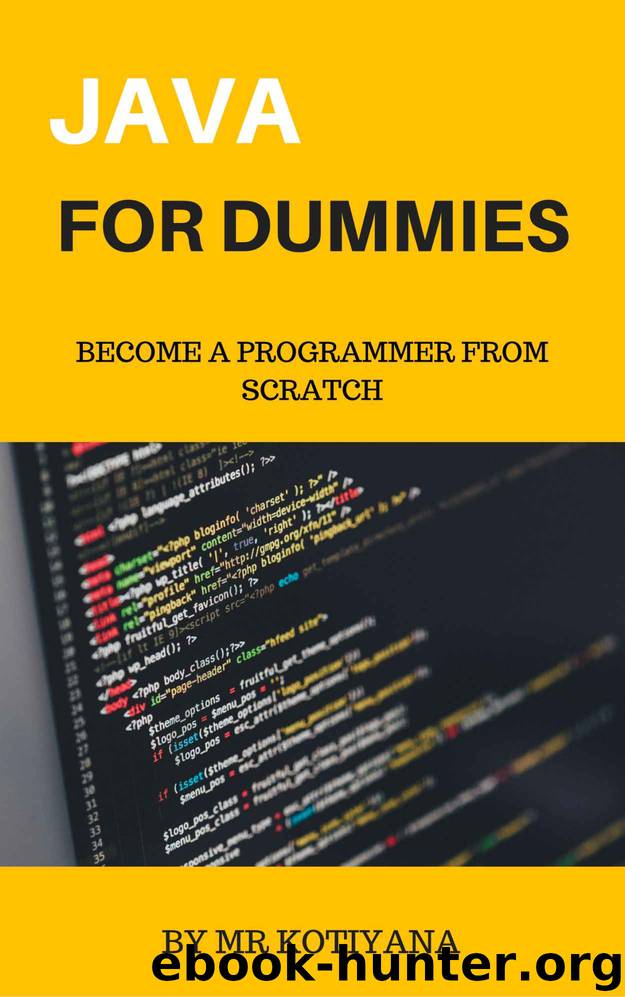Java For Dummies by Mr Kotiyana

Author:Mr Kotiyana [Kotiyana, Mr]
Language: eng
Format: azw3
Published: 2017-10-17T04:00:00+00:00
An object has an interface:
So, although what we really do in object-oriented programming is create new data types, virtually all object-oriented programming languages use the “class” keyword. When you see the word “type” think “class” and vice versa.
Since a class describes a set of objects that have identical characteristics (data elements) and behaviors (functionality), a class is really a data type because a floating point number, for example, also has a set of characteristics and behaviors. The difference is that a programmer defines a class to fit a problem rather than being forced to use an existing data type that was designed to represent a unit of storage in a machine. You extend the programming language by adding new data types specific to your needs. The programming system welcomes the new classes and gives them all the care and type checking that it gives to built-in types.
The object-oriented approach is not limited to building simulations. Whether or not you agree that any program is a simulation of the system you’re designing, the use of OOP techniques can easily reduce a large set of problems to a simple solution.
Once a class is established, you can make as many objects of that class as you like, and then manipulate those objects as if they are the elements that exist in the problem you are trying to solve. Indeed, one of the challenges of object-oriented programming is to create a one-to one mapping between the elements in the problem space and objects in the solution space.
But how do you get an object to do useful work for you? There needs to be a way to make a request of the object so that it will do something, such as complete a transaction, draw something on the screen, or turn on a switch. And each object can satisfy only certain requests. The requests you can make of an object are defined by its interface, and the type is what determines the interface. A simple example might be a representation of a light bulb:
Download
This site does not store any files on its server. We only index and link to content provided by other sites. Please contact the content providers to delete copyright contents if any and email us, we'll remove relevant links or contents immediately.
Deep Learning with Python by François Chollet(12696)
Hello! Python by Anthony Briggs(10006)
OCA Java SE 8 Programmer I Certification Guide by Mala Gupta(9871)
The Mikado Method by Ola Ellnestam Daniel Brolund(9868)
A Developer's Guide to Building Resilient Cloud Applications with Azure by Hamida Rebai Trabelsi(9767)
Dependency Injection in .NET by Mark Seemann(9419)
Hit Refresh by Satya Nadella(8863)
Algorithms of the Intelligent Web by Haralambos Marmanis;Dmitry Babenko(8381)
The Kubernetes Operator Framework Book by Michael Dame(7973)
Sass and Compass in Action by Wynn Netherland Nathan Weizenbaum Chris Eppstein Brandon Mathis(7836)
Test-Driven iOS Development with Swift 4 by Dominik Hauser(7806)
Grails in Action by Glen Smith Peter Ledbrook(7770)
Exploring Deepfakes by Bryan Lyon and Matt Tora(7765)
Practical Computer Architecture with Python and ARM by Alan Clements(7707)
Implementing Enterprise Observability for Success by Manisha Agrawal and Karun Krishnannair(7675)
Robo-Advisor with Python by Aki Ranin(7660)
The Well-Grounded Java Developer by Benjamin J. Evans Martijn Verburg(7650)
Building Low Latency Applications with C++ by Sourav Ghosh(7553)
Svelte with Test-Driven Development by Daniel Irvine(7535)
